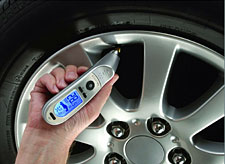
With the features below, we hope to keep you informed about the importance of correct tire pressure. Check back often to find new articles!
Information about Tire Safety
According to the National Highway Traffic Safety Administration (NHTSA), under-inflated tires are the leading cause of tire failure, which accounts for 660 fatalities and 33,000 injuries each year.
With many drivers planning road trips, Accutire and Michelin folks want to remind travelers to follow a three-point checklist that will help maintain optimal safety on the road and help the environment by increasing fuel efficiency.
Checking Tire Pressure
Before any long trip and once a month, properly check the pressure of each
tire with a tire gauge.?Under-inflated tires will make your tire wear
unevenly and negatively impact performance.?In addition, keeping your tire
pressure at the recommended level can boost fuel efficiency by one mile per
gallon. The car maker's recommended tire pressure can be found in several
places, including near the driver's door jam, on the glove compartment door
or in the owner's manual. Do not inflate tires to the maximum pressure
molded onto the tire's sidewall.
Check Tire Tread Depth and Replace Worn Tires
In most states, the minimum legal tread depth is 4/32 of an inch.?If you
place a penny with the top of the head facing down into your tires'
shallowest groove and you can see the top of Abraham Lincoln's head, it's
time to replace your tires.
Schedule Tire Rotation and Suspension Alignment
Have your car's suspension re-aligned when you buy new tires, especially if
you notice uneven wear or if it's been more then 10,000 miles since your
last alignment.?Also ask your tire dealer to rotate your tires every 6,000
to 8,000 miles.?Regular rotation extends the life of your tires which is
better for the environment, makes your vehicle safer and lowers overall tire
maintenance costs.?
Tips for Fuel Saving and Tires
With the large number of road trips taken each year and the average price of gas at reaching $4.00 per gallon, manufacturer associations and motorist safety groups are encouraging drivers to pay more attention to an often-abused part of their vehicles - the tires.
Safety
About one in every three cars has a significantly under inflated tire, and 660 fatalities and 33,000 injuries occur every year as a result of low tire pressure-related crashes according to the National Highway Traffic Safety Administration (NHTSA). At the same time, the AAA says it receives about 4 million roadside assistance calls each year due to tire-related incidents.
We also recommend that you check tires for worn-down treads that, while functioning effectively in dry weather, can lead to dangerous hydroplaning in the wet.
Save Fuel
With today's price of gasoline, increasing fuel efficiency is another good reason to pamper your rims. The most important thing that you can do to save fuel is to frequently check tire pressure. It's really all about maintaining air pressure - that's how you get the best wear, fuel economy and performance out of your tires. The U.S. Department of Energy (DOE). estimates that you can improve your gas mileage by about 3.3 percent by keeping your tires inflated to the proper pressure. For every pound per square inch that all four of a vehicle's tires are under-inflated, a driver's gas mileage is lowered by 0.4 percent. Some 3.56 million gallons of gas are wasted each day because of incorrectly-inflated tires, according to the DOE.
Keep checking that tire pressure to be safer on the highway and get the best gas mileage for your dollar.




